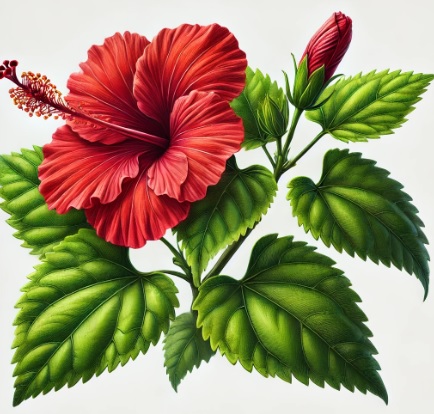Hawaiian hibiscus (Hibiscus rosa-sinensis), commonly known as the Chinese hibiscus, is a species of hibiscus native to East Asia, including China, India, and the surrounding regions. This plant is renowned for its large, vibrant flowers that come in a wide range of colors, including red, pink, orange, yellow, and white. The hibiscus is a tropical and subtropical plant that thrives in warm climates and is often used as an ornamental plant in gardens and landscapes.
Botanical Classification:
Kingdom: Plantae
Order: Malvales
Family: Malvaceae
Genus: Hibiscus
Species: Hibiscus rosa-sinensis
Plant Characteristics:
Hibiscus rosa-sinensis is characterized by:
Large, showy flowers that can be single or double, with colors ranging from red to pink, orange, yellow, and white, often with a contrasting central stamen
Glossy, dark green leaves that are ovate to lance-shaped, providing a lush backdrop for the flowers
A bushy growth habit, typically reaching heights of 1.5 to 3 meters with a similar spread, and can be grown as a shrub or small tree
Prefers warm, tropical to subtropical climates, and requires well-drained soil and plenty of sunlight to thrive
Chemical Composition and Structure:
The chemical composition of Hibiscus rosa-sinensis includes:
Essential oils with aromatic compounds such as citronellol, geraniol, and linalool, contributing to its pleasant fragrance
Flavonoids and anthocyanins in the petals, which offer antioxidant properties and contribute to the vibrant colors
Organic acids such as hibiscus acid and ascorbic acid (vitamin C) that provide additional health benefits
Uses and Benefits:
Aesthetic: Highly valued for its large, colorful flowers and ornamental appeal, making it a popular choice for tropical and subtropical gardens.
Cosmetic: Extracts are used in skincare products and hair care items for their moisturizing, anti-inflammatory, and antioxidant properties.
Medicinal: Traditionally used in herbal remedies for its potential benefits, including anti-inflammatory, anti-hypertensive, and diuretic effects. Hibiscus tea is commonly consumed for its potential health benefits.
Culinary: Flowers and leaves can be used in culinary applications, including teas, salads, and as a flavoring agent, adding a tart, citrus-like flavor.
Applications:
Gardening: Used as an ornamental shrub or small tree in gardens and landscapes, ideal for tropical and subtropical climates.
Cosmetics: Extracts incorporated into creams, lotions, shampoos, and conditioners for their beneficial properties and fragrance.
Medicinal: Used in teas and supplements for its potential health benefits, including antioxidant and anti-inflammatory effects.
Culinary: Fresh or dried petals used in cooking, particularly in beverages like hibiscus tea, and as a decorative and flavoring ingredient in various dishes.
Environmental and Safety Considerations:
Environmental Impact: Non-invasive and well-suited to tropical and subtropical environments; supports local pollinators like bees and butterflies.
Safety: Generally safe to handle and consume; however, individuals with allergies or sensitivities should exercise caution. It is advisable to consult with a healthcare provider before using hibiscus for medicinal purposes.
INCI:
Skin conditioning agent. It is the mainstay of topical skin treatment as it has the function of restoring, increasing or improving skin tolerance to external factors, including melanocyte tolerance. The most important function of the conditioning agent is to prevent skin dehydration, but the subject is rather complex and involves emollients and humectants that can be added in the formulation.
Synonyms:
CAS:
![]() Hawaiian hibiscus
Hawaiian hibiscus 
